The 11 dishes of the decade
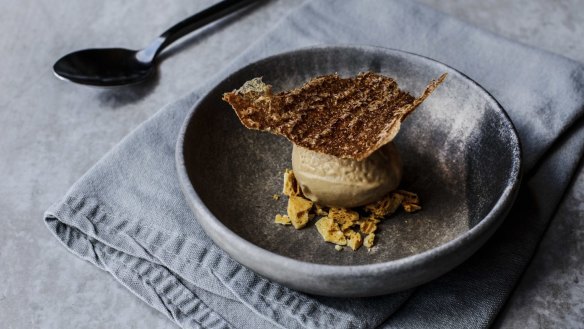
Gee, that went quick. Ten years of dry-ageing ducks and fish, of vegetables as heroes, of dusts and powders, and of umami everything. Ten years of zero waste, coastal succulents, smoke and fire, native ingredients and seriously seasonal menus. Ten years of our chefs rethinking the rules as they come to terms with changing climates, costs, demographics and a more positive kitchen culture.
So we felt we should celebrate the final month of the decade by identifying and honouring the finest dishes placed in front of us. But how do you follow the previous decade, with its guava snow egg from Quay, rich and noble lobster congee from Rockpool, slow-roasted lamb shoulder from Cumulus Inc, and Ortiz anchovy and tomato sorbet from MoVida? Here's how.
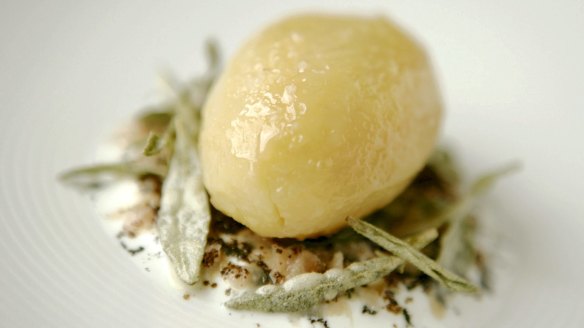
2010: EVERY DISH TELLS A STORY
A simple dish of potato cooked in the earth in which it was grown
If cooking is about creating compelling dishes, then a subtle switch occurred at the start of the decade, in which the most compelling dishes were those that came with their own origin story. This simple/not simple dish was inspired by the first hangi that Ben Shewry built as a child on farming country in New Zealand. Being a hungry 10-year-old at the time, he naturally dug it up long before the hot coals had cooked the potatoes. Cue 10-year-old with a stomach full of starchy raw potatoes.
Revisiting the idea in 2009, he cooked the potatoes between two layers of soil for six hours at 150C and two hours at 100C, waiting patiently as they took on the earthy flavour and aroma. Skinned and placed on a rich, creamy bed of smoked curd flavoured with coconut ash, mojama (salt-cured tuna), coffee and deep-fried saltbush, they became the landmark dish on his 2010 menu.
The potato left the Attica menu in 2014 to make room for more tall tales and true.
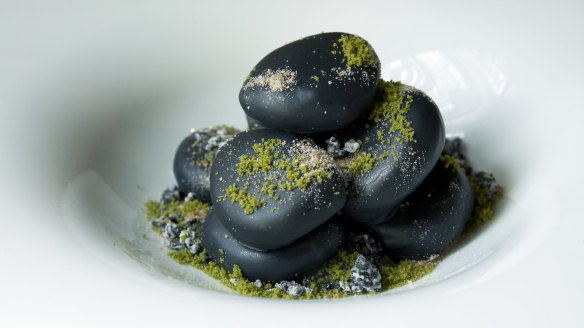
2011: TURNING JAPANESE
Japanese stones
Australian chefs have long been inspired by Japanese technique, philosophy and, above all, the concept of umami. But in 2011, it got personal.
The great East Japan earthquake of 2011 made quite an impact on Martin Benn of Sydney's Sepia (now shuttered), who greatly admires Japanese people and culture. Drawn to the notion of Japanese stones and rock gardens representing peace and tranquillity, he created an extraordinarily beautiful dessert in homage.
After much trial and error involving acts of alchemy and voodoo (well, OK, science, liquid nitrogen, carbonised bamboo powder and frozen cherry gel), he formed smooth-shelled, cracking-crisp pebbles of cherry, chocolate and coconut ice-cream and sorbet that rest on yuzu jelly, with green tea and mint moss, crystallised black sesame seeds and crystallised violets.
2012: THE RISE OF REGIONAL
Onion ice-cream with Wallington honeycomb, quinoa crisp and meyer lemon
When Loam opened on Victoria's Bellarine Peninsula in 2009, it was a long shot. Tucked away in an olive plantation on an unmade road, it had a menu that listed no dishes (just the ingredients of the season) from a young chef called Aaron Turner nobody had heard of.
But maybe it wasn't such a long shot after all. This was the year that a pub in western Victoria (the Royal Mail Hotel, with Dan Hunter in the kitchen) won The Age Good Food Guide Restaurant of the Year. Chefs were moving away from the big smoke to form more meaningful connections with the land – see James Viles of Biota in New South Wales and Michael Ryan of Provenance in Beechworth.
By 2012, critics were driving up those unmade roads, returning raving about Loam's savoury ice-cream of caramelised onion with local Wallington honeycomb (pictured top). That same uncompromising take on ultra-seasonal cooking is now installed at Igni in an anonymous laneway in Geelong. Another long shot is paying off.
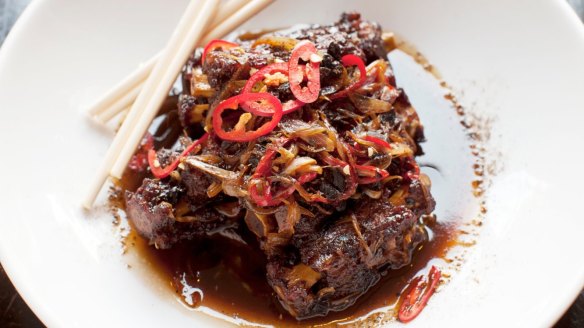
2013: AUSTRALIA DISCOVERS AUSTRALIA
Red-braised wallaby tail with black bean and chilli
In 2010, Kylie Kwong of Sydney's Billy Kwong was sitting in the audience at the Sydney Opera House as Rene Redzepi made an impassioned plea to Australian chefs to learn from its original people, and to make indigenous ingredients part of a cuisine that "looks like it belongs here". She called it "my lightbulb moment".
It was a lightbulb moment for Australia, not just Kylie Kwong. While some chefs resented being told what they were missing by an "outsider", Kwong made it her mission. The very next day she began chasing down indigenous ingredients and combining them with the Cantonese family cooking she had grown up with.
Fried salt bush cakes and roast duck with Davidson plum followed. By 2013, Kwong's on-going focus on sustainable and ethical food producers led her to Flinders Island, resulting in this sticky, messy red braise of Flinders Island wallaby, redolent with ginger, chilli and black bean. May it return with Kwong's next exciting Aussie-Chinese venture at South Eveleigh in 2020.
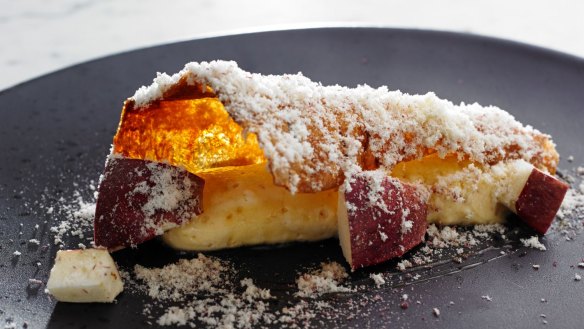
2014: THE VEGETABLE AS DESSERT
Slow-roasted parsnip and apple mousse
It has been quite the decade for vegetables. As meat costs rose due to drought, vegies rose in stature and presence on the nation's plates, in many cases infiltrating that last vegetable-free bastion of dessert.
Chef Dan Hunter had worked with parsnip since 2010 while at the Royal Mail in Dunkeld, but it wasn't until the day before he opened Brae in Birregurra in December 2013 that he cracked the magic code.
By 2014, Brae's parsnip dessert – a crisp, hollowed-out corpse of parsnip with a parsnip and apple mousse under a fuzz of tart dehydrated apple – had achieved near mythical status. "It's one of the most simple but tedious two-ingredient dishes on our menu," he says.
More than a dessert, it's a caramelised, earthy, sweetly acidic symbol of the role of our regional chefs in connecting the diner back to the landscape.
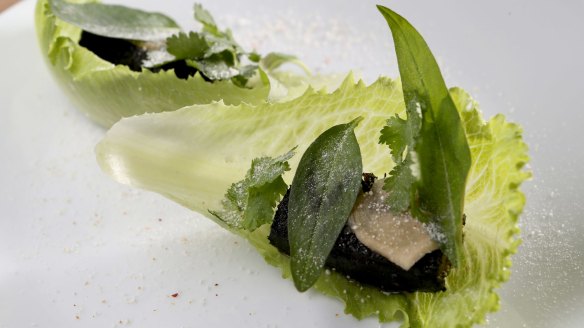
2015: EVERYONE IS WELCOME AT OUR TABLE
Vietnamese blood pudding with ginger, lettuce, herbs
The best dishes are not just exercises in texture, contrast and flavour, but are clearly shaped by the heritage and culture of the chef. This dish by Thi Le references her Vietnamese background, delivering a rich hit of steamed and fried blood pudding (much-loved in traditional cuisine) with the lightness and freshness of Asian herbs and ginger wrapped in a crisp cosberg leaf.
Fittingly, it marks the middle of a decade in which the different cultural backgrounds of young Australian chefs became our strength, forging the complex beast that is Australia's culinary identity. "There are hundreds of Vietnamese restaurants out there doing amazing traditional food," says Le. "This is my Australia, the Australia I want to replicate in my food."
Even the restaurant's mantra speaks to the future of Australian dining – modern Asian, modern Australian and a little bit in between.
2016: COOKING WITH FIRE
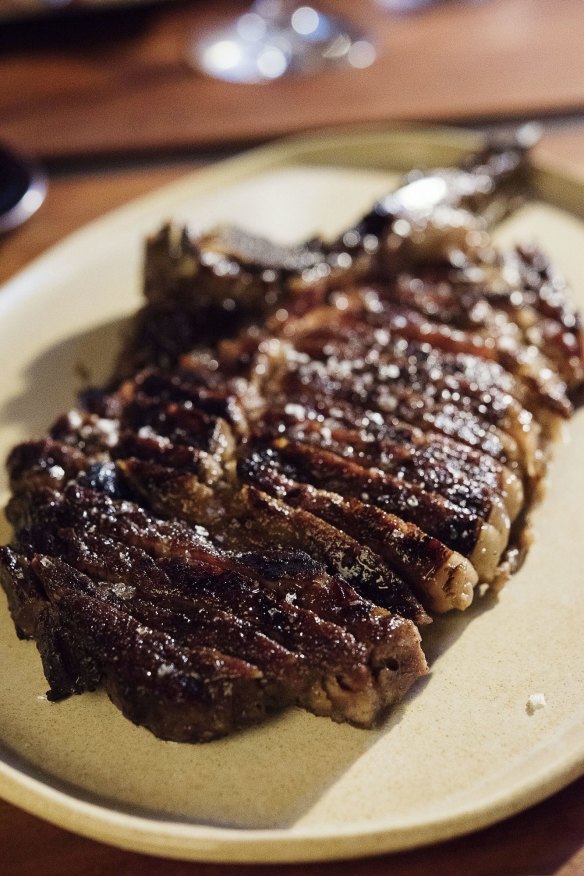
Dry-aged beef rib on the bone
The flames had been fanned for years at grill-houses such as Rockpool Bar & Grill and Porteno, but this was the year cooking over coals became the new normal, as piles of flinty grey ironbark lined the walls at Fred's in Paddington, Embla in Melbourne and Africola in Adelaide.
The Fink Group opened Firedoor in 2015 with Lennox Hastie at the all wood-fuelled (no gas) hearth. Former head chef of the famous Asador Etxebarri grill restaurant in Spain, Hastie's uncompromising process relied on adjustable grill racks, different types of woods and extreme ageing of meats to vary the intensity of heat, smoke and flavour.
By 2016, word was out: the 200-day aged Angus rib-eye on the bone was the holy grail. Cut to order with a band saw, showered with Olsson's fleur de sel and grilled over grapevines, it comes to the table crusty and smoky, tasting deeply savoury and almost fruity. Slow food – grown, aged, cooked – at its finest.
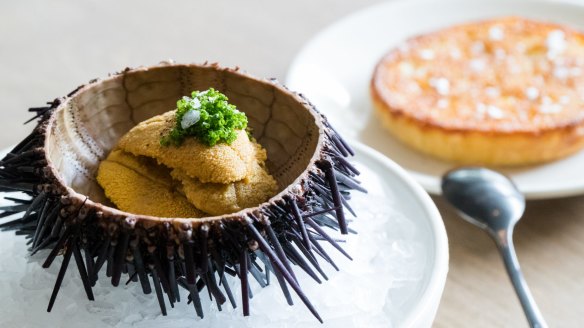
2017: EATING THE PROBLEM
Sea urchin crumpet
At this stage of the decade, we got serious about fish. We loved the new Cirrus in Sydney for its smoked ocean trout parfait, and the new Iki-Jime in Melbourne for its deconstructed "prawn cocktail". By applying fine dining technique to our very best fish and shellfish, chefs were evolving a newly coastal cuisine that seemed as Australian as hell.
Then along came Saint Peter, and a young chef who was so serious about fish that he aged it to intensify its flavour, and used everything from the liver to cheek, belly and tail, to reduce waste. In 2017, aware that sea urchins were so invasive a species that they could destroy 30 metres of the ocean's kelp forests a year, he sent out briny Taren Point sea urchin on buttery, house-made crumpets. As the national editor of the Good Food Guide, Myffy Rigby, said at the time: "The combination of very hot crumpet and very cool sea urchin is simultaneously slightly disconcerting but also mind-bendingly delicious."
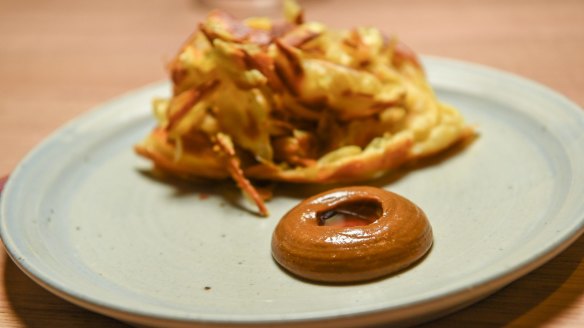
2018: HANDS-ON SNACKERY
Roti with Vegemite curry
Who knew that the humble jar of Vegemite would be such a muse? By 2018, everyone wanted a little bit of Australia's own umami bomb on their plates, with Vegemite pies, pastry scrolls, mayo, and in one spectacular example (Dinner by Heston, Melbourne), Vegemite ice-cream. But the prize for Best Use of Black, Salty Breakfast Spread goes to Khanh Nguyen of Melbourne's game-changing Sunda, where it played straight into our love of flatbreads, Asian spice and hands-on snackery.
Having previously interned at Noma's Sydney residency, where they made Vegemite from scratch, Nguyen was inspired to develop a Vegemite "curry", a rich swirl of buttery sour cream, roasted yeast and Vegemite topped with a soft curry oil and served with pull-apart roti bread for dipping and swiping. On occasion, he adds a shower of finely shaved truffles, which makes for happy little Vegemites indeed.
TIED WITH...
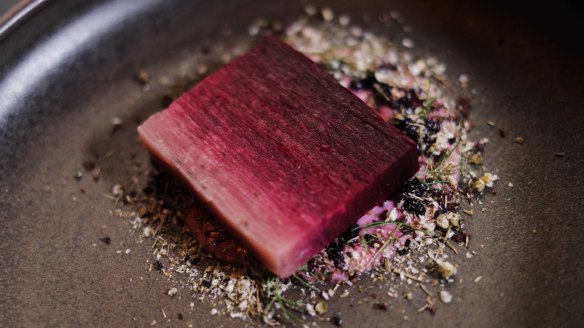
2018: YES, MORE VEGETABLES. WE CAN'T GET ENOUGH OF THEM
Beetroot terrine
Single-use vegetables – it's a thing. Remember Porteno's brussels sprouts? Ester's roasted cauliflower? Lee Ho Fook's crisp, fish-fragrant eggplant?
When Dave Verheul opened Lesa in August 2018, he wanted to do the beetrootiest beetroot dish known to humanity. It's an obsessive dish, with more than 100 slices of beetroot layered in graduated colours of red to magenta to candy-striped, baked for two hours, then lightly pressed overnight.
Served in a small, exquisitely striped block with preserved cherries and cherry vinegar, fermented elderberries and the crunch of dried olives, it's disturbingly beautiful.
2019: KEEPING IT SIMPLE, LIKE A NONNA
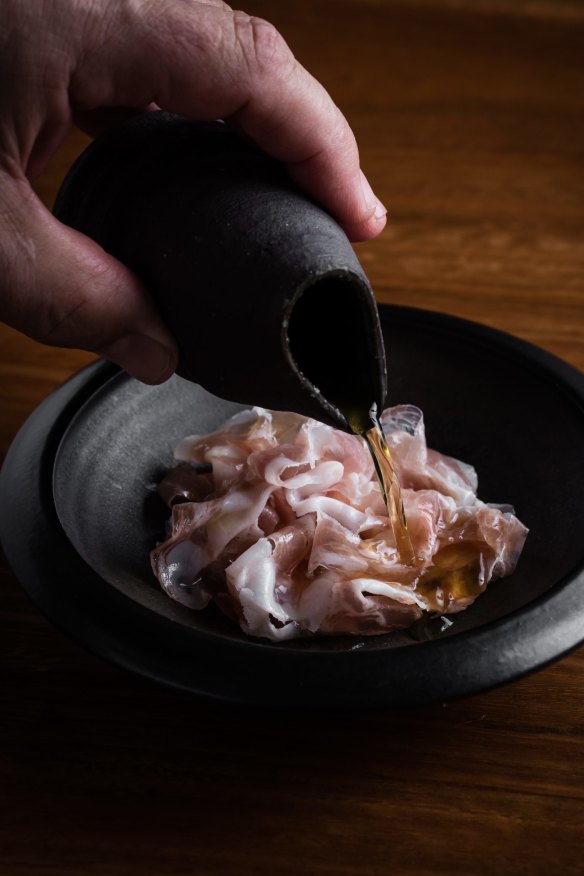
Traditionally cured salumi, gentle render in salumi broth
And so we wind up the decade with Peter Gilmore's final creation for 2019, which appeared on the ever-evolving menu at Quay in early November.
Gilmore asked artisan producers De Palma to make a slow-cured salami from the famed Berkshire black pig, using lots of fat and lots of salt – no garlic, no fennel, no chilli – and plenty of good, old-fashioned time. The genius lies in the pouring of a clean, luminous broth made from the salami itself over the finely ruffled, sliced salami, allowing the heat to soften and melt the pure white fat. Sweetly fragrant, it is somehow reminiscent of a nonna's tortellini in brodo, without the tortellini.
This dish not only symbolises the best aspects of 2019 – the resurgence of all things Italian, a renewed respect for the slow-food, artisanal crafts of curing and preserving, and the growing confidence of our top chefs in keeping things simple – it sets exactly the right tone as we move into a delicious new decade.
Restaurant reviews, news and the hottest openings served to your inbox.
Sign up- More:
- Best of